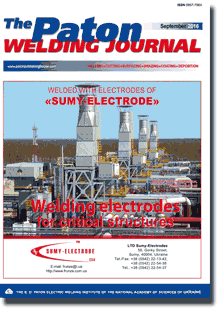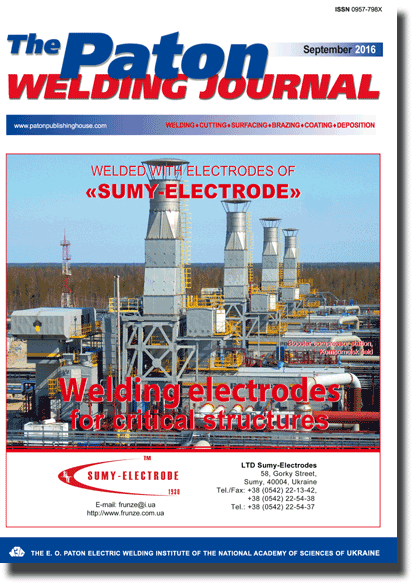| 2016 №09 (05) |
DOI of Article 10.15407/tpwj2016.09.06 |
2016 №09 (07) |

The Paton Welding Journal, 2016, #9, 30-32 pages
Effect of current pulses on activation of welded surfaces of plates from dissimilar metals (steel 20 + copper M1)
L.I. Markashova1, N.A. Onatskaya2 and L.Yu. Demidenko2
1E.O. Paton Electric Welding Institute, NASU 11 Kazimir Malevich Str., 03680, Kiev, Ukraine. E-mail: office@paton.kiev.ua
2Institute of Pulse Processes and Technologies, NASU 43-A Oktyabrsky Ave., 54018, Nikolaev, Ukraine. E-mail: iipt@iipt.com.ua
Abstract
Presented are the results of engineering process of welding of plates from dissimilar metals (steel 20 + copper M1) under conditions of passing of high-density current pulses. Pulse current generator GIT-50, developed in the Institute of Pulse Processes and Technologies of the NAS of Ukraine, was used for welding processes activation. Application of complex investigation method allowed determining that different stages of the process of welded joint formation take place on a contact interaction surface of macroscopic size. It is caused by inhomogeneity of the real surfaces of solid bodies even at high class of their treatment. The results of examination of steel surface fine structure indicate that treatment of the preliminary compressed plates with the high-density pulses results in significant activation of the dislocation transformations, having significant effect on development of the third stage of solid state welding process, i.e. stage of volumetric interaction. 7 Ref., 2 Figures.
Keywords: welded joints, dissimilar materials, high-density current pulses, contact zone, electron microscopy, dislocation structure, activation of contact surface
Received: 23.12.15
Published: 09.10.16
References
- Middeldorf, K., von Hofe, D. (2008) Trends in joining technology. The Paton Welding J., 11, 33–39.
- Reisgen, U., Stein, L., Steiners, M. (2010) Stahl-Aluminium-Mischverbindungen: Schweissen oder Loeten? Die Kombination zweier etablierter Fuegetechnologien macht Unmoegliches moeglich. Schweissen und Schneiden, 62(5), 278–284.
- Karakozov, E.S. (1976) Joining of metals in solid phase. Moscow: Metallurgiya.
- Karakozov, E.S. (1986) Pressure welding of metals. Moscow: Mashinostroenie.
- Troitsky, O.A., Baranov, Yu.V., Avraamov, Yu.S. et al. (2004) Physical principles and technology of treatment of modern materials. Vol.1: Theory, technology, structure and properties. Moscow; Izhevsk: IKI.
- Onatskaya, N.A., Demidenko, L.Yu. (2010) Influence of circuit processing by current pulses on formation of physical contact in pressure welding. Obrab. Materialov, 3, 19–21.
- Vovchenko, A.I., Demidenko, L.Yu., Onatskaya, N.A. (2011) Intensification of plastic deformation of metal surfaces under action of current pulses in pressure welding. Naukovi Notatky, 32, 63–68.
Suggested Citation
L.I. Markashova, N.A. Onatskaya and L.Yu. Demidenko (2016) Effect of current pulses on activation of welded surfaces of plates from dissimilar metals (steel 20 + copper M1). The Paton Welding J., 09, 30-32.The cost of subscription/purchase order journals or individual articles
| Journal/Currency | Annual Set | 1 issue printed |
1 issue |
one article |
| TPWJ/USD | 384 $ | 32 $ | 26 $ | 13 $ |
| TPWJ/EUR | 348 € | 29 € | 24 € | 12 € |
| TPWJ/UAH | 7200 UAH | 600 UAH | 600 UAH | 280 UAH |
| AS/UAH | 1800 UAH | 300 UAH | 300 UAH | 150 UAH |
| AS/USD | 192 $ | 32 $ | 26 $ | 13 $ |
| AS/EUR | 180 € | 30 € | 25 € | 12 € |
| SEM/UAH | 1200 UAH | 300 UAH | 300 UAH | 150 UAH |
| SEM/USD | 128 $ | 32 $ | 26 $ | 13 $ |
| SEM/EUR | 120 € | 30 € | 25 € | 12 € |
| TDNK/UAH | 1200 UAH | 300 UAH | 300 UAH | 150 UAH |
| TDNK/USD | 128 $ | 32 $ | 26 $ | 13 $ |
| TDNK/EUR | 120 € | 30 € | 25 € | 15 € |
AS = «Automatic Welding» - 6 issues per year;
TPWJ = «PATON WELDING JOURNAL» - 12 issues per year;
SEM = «Electrometallurgy Today» - 4 issues per year;
TDNK = «Technical Diagnostics and Non-Destructive Testing» - 4 issues per year.


